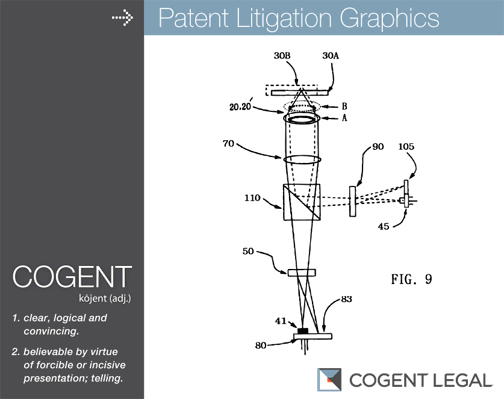This post is by Dave Nugent, Senior Producer at Cogent Legal
 Early in my career as a Litigation Media Producer, I supported an attorney’s tutorial and Markman presentation in a Federal District Court patent matter. The case was assigned a studious, no-nonsense IP judge. For the tutorial, she often would enter the courtroom nearly as well versed on the case and technology as anyone in the room. She would use the tutorial hearing as an opportunity to fill any potential holes in her understanding of the case and technology at issue.
Early in my career as a Litigation Media Producer, I supported an attorney’s tutorial and Markman presentation in a Federal District Court patent matter. The case was assigned a studious, no-nonsense IP judge. For the tutorial, she often would enter the courtroom nearly as well versed on the case and technology as anyone in the room. She would use the tutorial hearing as an opportunity to fill any potential holes in her understanding of the case and technology at issue.
Our lead attorney, however, wanted to prepare his tutorial in a style he was most comfortable with—a linear step-by-step PowerPoint overview of the industry background, prior art, and the problems or needs that the invention addressed.
When our attorney launched straight into his linear presentation with his recitation of the invention’s background and prior art, the judge showed immediate impatience, and abruptly waved the flustered attorney off with a terse, “I read all that in your brief, counsel. I have some questions for you.”
Rattled and fairly embarrassed before the assembled court, the attorney tried to answer the questions while associates were trying to hunt through the PowerPoint in working mode, to find relevant sections that were buried deep in the rigidly sequential PowerPoint. This process was slow, cumbersome, disruptive and added further irritation to the judge’s patience and poor assessment of our legal team’s perceived preparedness!
It was a bad day in court.


 When it comes to construction issues, I feel like the actor in that old ad on TV who says, “I’m not a doctor, but I play one on TV.” I’m not in the construction field, but I litigated construction cases for over a decade and consequently couldn’t help but develop an expertise in construction standards and practices. In a similar way, some med-mal attorneys I know have a better understanding of proper standard of care than even doctors do. When you have to prosecute or defend a case that revolves around highly technical issues, you’re sure to learn the subject inside and out.
When it comes to construction issues, I feel like the actor in that old ad on TV who says, “I’m not a doctor, but I play one on TV.” I’m not in the construction field, but I litigated construction cases for over a decade and consequently couldn’t help but develop an expertise in construction standards and practices. In a similar way, some med-mal attorneys I know have a better understanding of proper standard of care than even doctors do. When you have to prosecute or defend a case that revolves around highly technical issues, you’re sure to learn the subject inside and out. This is an abridged version of an article I wrote for the September 2012 issue of the
This is an abridged version of an article I wrote for the September 2012 issue of the 



Follow Cogent Legal
Subscribe by Email